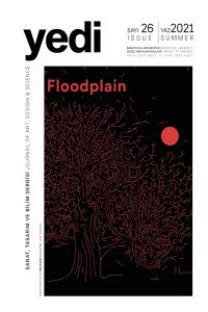MÜZE VE TOPLUM İLİŞKİLERİNDE EĞİTİM, SOSYAL HAREKET VE KATILIMIN YENİ BOYUTLARI
müzecilik, müze eğitimi, katılım, toplum, sosyal hareket
___
- American Association of Museums (AAM) (2021, 18 Ocak). Principles and standarts. https://www.aam-us.org/programs/ethics-standards-and-professional-practices/
- Black, G. (2005). The engaging museum: developing museums for visitor involvement. Routledge.
- Bryant, E.; Mileham, E. (2010). Shhh… it is a secret! exhibition report. Wallace Collection.
- Demirdelen, H. (2012). Anadolu Medeniyetleri Müzesi Eğitim Etkinlikleri. Nevra Ertürk ve Hanzade Uralman (Ed.), Müzebilimin ABC’si, (s. 209-229) içinde. Ege Yayınları.
- Erdoğan, N. (2014). Mardin müzesi müze eğitimi etkinlikleri. Mardin Müzesi Müdürlüğü.
- Gordon P. (2005). Community Museums: The Australian Experience. In Gerard Corsane (Ed.), Heritage, museums and galleries: an introductory reader (pp. 357-364). Routledge.
- Greenhill, H., E. (2007). Museums and education. purpose, pedagogy, performance. Routledge.
- Hein, G. (2012). Progressive museum practice: john dewey and democracy. Left Coast Press.
- Hein, G. (2013). Progressive museum education: examples from the 1960s. International Journal of Progressive Education, 9 (2), 61-76.
- Henning, M. (2006). Museums, media and cultural theory. Berkshire Open University Press.
- ICOM (2019, 28 Temmuz). International Council of Museums’ Museum Definition. https://icom.museum/en/activities/standards-guidelines/museum-definition/
- ICOM (2020, 24 Kasım). Museums and COVID-19: 8 steps to support community resilience. https://icom.museum/en/news/museums-and-covid-19-8-steps-to-support-community-resilience/
- ICOM Social Media Guidelines (2019, 9 Mayıs). Social Media Guidelines. https://icom.museum/wp-content/uploads/2019/10/Social-media-guidelinesEN-1.pdf
- ICOM Report (2020, 9 Mayıs). Survey: Museums, Museum Professionals and COVID – 19. https://icom.museum/en/covid-19/surveys-and-data/survey-museums-and-museum-professionals/
- ICOM (2020, 30 Aralık). Report on Museums, Museum Professionals and COVID-19. https://icom.museum/wp-content/uploads/2020/05/Report-Museums-and-COVID-19.pdf
- Jalving, P. (2017). The art of taking part: participation at the museum. ARKEN Bulletin Denmark Museum of Modern Art, 7, 115-131.
- Kaynak, A., Çolak, C. (2011, 10 Ağustos). Engelsiz müze rehberi. İstanbul Sağlık Müdürlüğü: İstanbul Sağlık Müzesi. http://www.istanbulsaglik.gov.tr/w/smuzesi/belge/engelsiz_muze_rehberi.pdf
- King, B. (2007). New relationships with the formal education sector. In Lord, B. (Eds.), The Manual of Museum Learning (pp.77-105). Alta Mira Press.
- Kreps, C. (2009). Foreword. In Museums as places for intercultural dialogue: selected practices from europe, (pp: 4-5). MAP for ID Project Group.
- Lang, C., Reeve, J. & Woollard, V. (2006). So where we go from here? In C. Lang, J. Reeve ve V. Woollard (Eds.), The Responsive Museum (pp: 227-237). Ashgate.
- Latham, K. F., Jaede, K. F. (2021). Take that COVID! Positive Documents Emerging from the Museum Sector. Proceedings from the Document Academy, 8 (2), 13. https://doi.org/10.35492/docam/8/2/13
- Lucija, A.; Durksen, T. & Volman, L. M. (2017). Museums as avenues of learning for children: a decade of research. Learning Environments Research 20 (1): 47-76.
- Maffei, N. (2014). John Cotton Dana and the politics of exhibiting industrial art in the US, 1909 – 1929, Journal of Design History, 13(4), 301-317.
- Malraux, A. (1956). Museum without walls. The voices of silence. Secker&Warburg.
- National Survey of COVID-19 Impact on United States Museums (2020, 30 Aralık). American Alliance of Museums Report. https://www.aam-us.org/wp-content/uploads/2020/07/2020_National-Survey-of-COVID19-Impact-on-US-Museums.pdf
- Network of European Museum Organizations Report (2020, 6 Mayıs). Report on Museums: Museum Lives in Post- Pandemia. https://www.ne-mo.org/news/article/nemo/now-online-nemo-webinar-museum-lives-in-post-pandemia.html
- Onur, B. (2014). Yeni müzebilim: demokratik toplumu yaratmak. İmge Kitabevi Yayınları.
- Onur, B. (2012). Çağdaş müze, eğitim ve gelişim: müze psikolojisine giriş. İmge Kitabevi Yayınları.
- Preziosi, D.; Farago, C. (2004). Grasping the world. The idea of the museum. Ashgate Publishing.
- Reeve, J. (2006). Prioritizing audience groups. In C. Lang, J. Reeve; V. Woollard (Eds.), The Pesponsive Museum (pp. 43-60). Ashgate Pub. Ltd.
- Reeve, J., Woollard, V. (2006). Influences on museum practice. In C. Lang ve J. Reeve, (Eds.), The Responsive Museum (pp. 5-17). Asgate Pub. Ltd.
- Ross, M. (2004). Interpreting the new museology. Museum and Society, 2(2): 84-103.
- Sandell, R. (2003). Social inclusion, the museum and the dynamics of sectoral change. Museum and Society, 1(1), 45-62.
- Sandell, R., Nightingale, E. (2012). Museums, equality and social justice. London and New York.
- Simon, N. (2010). The participatory museum. Muzeum Z.O.
- Tlili, A. (2008). Behind the policy mantra of the inclusive museum: receptions of social exclusion and inclusion in museums and science centres. Cultural Sociology, 2(1):123-147.
- Walsh, K. (1992). The representation of the past: museums and heritage in the post-modern world. Routledge.
- Watson, S. (2007). Museums and their communities. In S. Watson (Ed.), Museums and their Communities (pp. 2-25). Routledge.
- Zeller, T. (1989). The historical and philosophical foundations of art museum education in America. In N. Berry and S. Mayer, (Eds), Museum education history, theory, and practice. The National Art Education Association.
- ISSN: 1307-9840
- Başlangıç: 2007
- Yayıncı: Dokuz Eylül Üniversitesi
MÜZE VE TOPLUM İLİŞKİLERİNDE EĞİTİM, SOSYAL HAREKET VE KATILIMIN YENİ BOYUTLARI
Sinemada Mekân: The Fall Filmi’nde Göstergebilimsel Yaklaşımla Mekân Okumaları
Filiz ÇELİK, Begüm Dilara ARSLAN, Fikriye YILDIZ, Merve KALP
Yörüklerde Müzik ve Boğaz Çalma
Çağdaş Tekstil Sanatında Aplike Tekniği
Tugba SELÜK ALTUNÖZ, Yüksel ŞAHİN
Filmlerle Tarih Yazmak: İstanbul’un Fethi Örneği
Lacan’ın Kavramlarıyla Genet’nin Hizmetçiler ve Balkon’unu Okumak
Simel KEÇİCİOĞLU, Banu Ayten AKIN
Devam Oyunlarında Alımlama: Tarla Kuşuydu Juliet, Nina ve Nora 2
360 Fotoğraf Tasarımında Aksiyon Kamerası ve Post Manzara Anlayışı Üzerine Analizler
Sürdürülebilir Tekstiller Kapsamında Evsel Organik Atıklarla Bojagi-Jogakbo’nun Yeniden Yorumlanması
Eşitlikçi Bir Tasarım Hareketi Olarak ‘Kendin Yap’ ve Modaya Yönelik Uygulamalar
